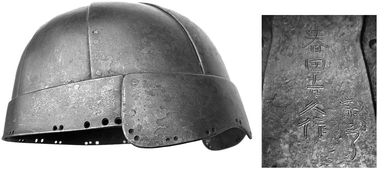Phase composition mapping of a 17th century Japanese helmet
Abstract
Neutron Diffraction represents the ideal technique for the characterisation of the micro-structural properties of ancient metals, allowing retrieval of information on the smelting process, and the mechanical and thermal treatments applied during the manufacture of the sample. The object under investigation is a 17th century Japanese helmet (kabuto) from the Haruta School that has already been analysed, along with other six similar examples, using a general purpose neutron diffractometer. Through this study, the quality of the steel (phase composition) was determined and information on the thermo-mechanical treatments applied was inferred, averaging over a scattering volume that affected the entire thickness of the sample. The Haruta kabuto stood out for its very high carbon content, the absence of texture and residual strain, and very big grain size. These factors and the presence of incomplete reduction of the ore sand suggest the presence of plates with a composite structure of layers of steel and iron superimposed. This paper shows the possibility of using neutron diffraction on a highly collimated instrument, such as ENGIN-X (ISIS, UK), to be able to select a very small gauge volume and, this way, to detect variations in the phase composition along the thickness of the plates. Here we present novel results from diffraction measurements by using the instrument ENGIN-X. This study completes the previous cycle of neutron measurements on this sample and sheds light on the structure of the plates.

- This article is part of the themed collection: Synchrotron radiation and neutrons in art and archaeology

 Please wait while we load your content...
Please wait while we load your content...